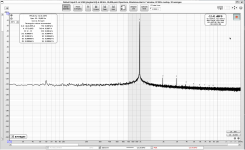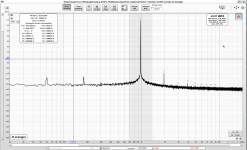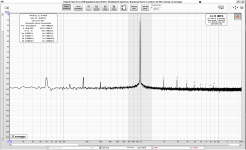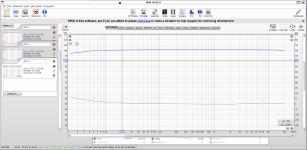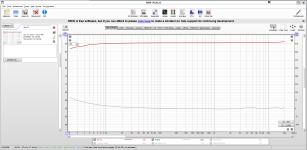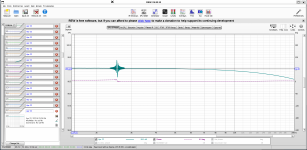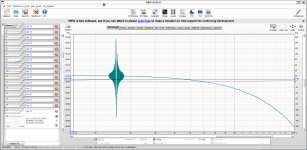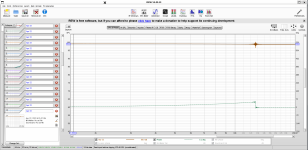Hi All,
Following a morning used up with plumbers fixing things in the house, I've spent the afternoon playing with REW. Here are three measurements of Tombo56's buffer, done under the same circumstances as far as was possible, namely an input voltage of 0.5V peak-to-peak, and volume set to unity gain (or as close as the AVC would allow). The first is from the preamp I built previously, the second and third from the new experimental one in the photo a couple of posts above. The difference between the second and third is that volume has been controlled by the pots on the input in the second (with the AVC on "full"), and by the AVC on the output in the second (with the input pots on full).
The plot for the first buffer, which was built with much more care with the layout than the experimental rig, doesn't have the peaks at multiples of 60 Hz that the others show. Considering my almost criminal lack of care in building the experimental rig this is hardly surprising; running signal wires more carefully (!) might well reduce these peaks, although they're pretty small in absolute terms. Also the power supply for the second and third plots is just thrown together with parts from my junkbox, which shows how good tombo56's on-board is.
The absolute best of the three seems to be the one using the AVC and not the pot on the input, although the differences in distortion and noise are surely not audible.
Nothing is perfect, though. Firstly, listening to music on the experimental version was tiring; something in the upper registers seemed (subjectively) a little harsh. This doesn't happen at all with the other preamp based on the same buffers. I can think of two possible explanations; I didn't have anything in for C5 (which seems less likely to be the problem), or I may have been inadvertently listening louder than I usually do.
If the second it may be linked to trying to use the AVC instead of the input pot. Please correct me if any of the following sounds wrong. There are seven "clicks" up from silence on this AVC, each of which is the same number of turns, hence the same voltage difference. (There is a problem with one of the pins on one of them, hence seven, not eight.) So the last step is an increase in a ratio of 7 to 6, which is around 1.34 dB, whereas the step between 2 and 3 is 3.5dB. In practice, if I want to avoid using the pot on the input then on my system a buffer with unity gain puts me at the top end where the volume control is more useful (which is more or less what ZM hinted might happen earlier, I think), whereas these buffers (with a gain of 1.33) leave me already in the middle since anything above is too loud and the increments up or down are too coarse to be useful. So the moral of the story if someone else want to be try transformers like these as a cheap AVC then their success or failure really depends on whether you usually listen to music near 10, or near 2 or 3.
In any event, I have switched back to the Cedarburg boards (which are unity gain) and am listening to them now. They sound very good. I've also messed around with them in REW, but I'm already drifting OT.
Following a morning used up with plumbers fixing things in the house, I've spent the afternoon playing with REW. Here are three measurements of Tombo56's buffer, done under the same circumstances as far as was possible, namely an input voltage of 0.5V peak-to-peak, and volume set to unity gain (or as close as the AVC would allow). The first is from the preamp I built previously, the second and third from the new experimental one in the photo a couple of posts above. The difference between the second and third is that volume has been controlled by the pots on the input in the second (with the AVC on "full"), and by the AVC on the output in the second (with the input pots on full).
The plot for the first buffer, which was built with much more care with the layout than the experimental rig, doesn't have the peaks at multiples of 60 Hz that the others show. Considering my almost criminal lack of care in building the experimental rig this is hardly surprising; running signal wires more carefully (!) might well reduce these peaks, although they're pretty small in absolute terms. Also the power supply for the second and third plots is just thrown together with parts from my junkbox, which shows how good tombo56's on-board is.
The absolute best of the three seems to be the one using the AVC and not the pot on the input, although the differences in distortion and noise are surely not audible.
Nothing is perfect, though. Firstly, listening to music on the experimental version was tiring; something in the upper registers seemed (subjectively) a little harsh. This doesn't happen at all with the other preamp based on the same buffers. I can think of two possible explanations; I didn't have anything in for C5 (which seems less likely to be the problem), or I may have been inadvertently listening louder than I usually do.
If the second it may be linked to trying to use the AVC instead of the input pot. Please correct me if any of the following sounds wrong. There are seven "clicks" up from silence on this AVC, each of which is the same number of turns, hence the same voltage difference. (There is a problem with one of the pins on one of them, hence seven, not eight.) So the last step is an increase in a ratio of 7 to 6, which is around 1.34 dB, whereas the step between 2 and 3 is 3.5dB. In practice, if I want to avoid using the pot on the input then on my system a buffer with unity gain puts me at the top end where the volume control is more useful (which is more or less what ZM hinted might happen earlier, I think), whereas these buffers (with a gain of 1.33) leave me already in the middle since anything above is too loud and the increments up or down are too coarse to be useful. So the moral of the story if someone else want to be try transformers like these as a cheap AVC then their success or failure really depends on whether you usually listen to music near 10, or near 2 or 3.
In any event, I have switched back to the Cedarburg boards (which are unity gain) and am listening to them now. They sound very good. I've also messed around with them in REW, but I'm already drifting OT.
Attachments
You got it right. 😛tombo is my guy, not so allergic on OT
@njepitt, don’t bother with what might be off topic. You can discuss and compare other input buffers here.
C5 absence will not affect high frequency distortion, so I suspect it is higher listening level responsible. Transformers may not have linear response at high frequency (as is known for Edcor in example). It would be good to check FR using REW sweep mode.
Hi Tombo,
I hadn't used REW to give a sweep response before, except when using a mic to measure speakers, so I hope this is what you meant. Here are two sweeps I did with the same conditions on REW, as far as I could tell, one for Tombo's buffer (the first one, without AVC), and the second with the Cedarburg buffers using the AVC. I don't think output volume was the same on the two preamps, but settings on the Focusrite were the same. As far as I can see there isn't a lot to choose between them; both look pretty flat to me, and there doesn't seems to be any smoking gun in the higher frequencies from the Edcor transformers. I am presuming that any strange frequency response would show up with any of the buffers. Let me know if you had something different in mind, or if some other settings would be more appropriate.
I can produce something similar when I can put the other buffers back in the experimental rig, but that may be a few days, since the sound from the Cedarburg/AVC combo is really nice. Enjoying a little Scriabin piano music right now...
Best regards
Nigel
I hadn't used REW to give a sweep response before, except when using a mic to measure speakers, so I hope this is what you meant. Here are two sweeps I did with the same conditions on REW, as far as I could tell, one for Tombo's buffer (the first one, without AVC), and the second with the Cedarburg buffers using the AVC. I don't think output volume was the same on the two preamps, but settings on the Focusrite were the same. As far as I can see there isn't a lot to choose between them; both look pretty flat to me, and there doesn't seems to be any smoking gun in the higher frequencies from the Edcor transformers. I am presuming that any strange frequency response would show up with any of the buffers. Let me know if you had something different in mind, or if some other settings would be more appropriate.
I can produce something similar when I can put the other buffers back in the experimental rig, but that may be a few days, since the sound from the Cedarburg/AVC combo is really nice. Enjoying a little Scriabin piano music right now...
Best regards
Nigel
Attachments
when looking for details, and actual transfer characteristic is allowing, set higher resolution - smaller db window
Transformer doesn’t exhibit any peaks in FR response, so that reason for perceived distortion can be ruled out. Although, only Cedarburg buffer was measured with AVC at the output, I don’t believe it is possible that other buffers would produce different FR.
What next? Answer is simple. You have combination which works well. Use Cedarburg with AVC and enjoy listening. 😀
You’ll easily find other duties for “Blasphemy” buffer.
What next? Answer is simple. You have combination which works well. Use Cedarburg with AVC and enjoy listening. 😀
You’ll easily find other duties for “Blasphemy” buffer.
I had a go at higher resolution sweeps and a "smaller dB window", as ZM asked. I only scanned from 1500Hz up. Something a little odd appeared. This is all still using the Cedarburg buffers and the Edcors, with volume pots set to max, and only adjusting volume with the AVC. Something is causing these "ringing" events, which happen about half the time, do not seems to happen at the same frequency every time, and only happen once every sweep if they appear at all. My best guess is that these are artefacts of the measurement, but it is possible that some kind of outside interference is being picked up, I suppose. Did I perhaps set something wrong in REW? I don't find the interface very intuitive, but note I'm using the linux version, which may not look the same as the windows or mac versions, and (as always) it's very possible I'm doing something wrong. The only thing that struck me was the abrupt shift in phase that happens at the same time; that doesn't look like an analogue process to me.
The screenshots below show two scans, both shown with wider and narrower resolution. Like I said above, about half the time these "blips" don't appear.
Thoughts?
The screenshots below show two scans, both shown with wider and narrower resolution. Like I said above, about half the time these "blips" don't appear.
Thoughts?
Attachments
My guess was something like that. Are these caused generated by the computer itself, or the Focusrite? If the laptop, do you think these are produced when using a computer to play back music? They're pretty small, but maybe not completely ignorable.
Nothing else about these scans looks remarkable, right? Do they have the resolution you asked for?
Nothing else about these scans looks remarkable, right? Do they have the resolution you asked for?
I'm good...... my remark was for your benefit, not me being suspicious or expecting different results
blips - who cares, digital ones, most important is that you are not hearing any while listening, hardly anything related to 'puter side, more likely to measuring software/settings
and certainly not having origin in liner domain, which was target of investigation in first place
blips - who cares, digital ones, most important is that you are not hearing any while listening, hardly anything related to 'puter side, more likely to measuring software/settings
and certainly not having origin in liner domain, which was target of investigation in first place
Hi ZM,
I'm certainly not hearing any blips while listening, so no worries there, and if these blips aren't linked to the transformers then they aren't linked to the listening fatigue I heard before.
Here's a totally different idea. I've been thinking about putting these transformers (and a choice of buffers) in a more permanent chassis. You were right about not needing as many steps on an AVC as I had thought (so as you say, you're good... although I don't think that's quite what you meant... 🤣 ), although how useful the increments are depends very much on the level of the recording I'm listening to. So I wouldn't want to do without the input pots completely, since sometimes they'd be needed, but most of the time they're set on full and I'm just choosing the level on the Edcors.
), although how useful the increments are depends very much on the level of the recording I'm listening to. So I wouldn't want to do without the input pots completely, since sometimes they'd be needed, but most of the time they're set on full and I'm just choosing the level on the Edcors.
So in a permanent build I'm thinking I could mount a push-button switch to connect/disconnect the input pots (and the wiring needed for them) leaving just the AVC. This would be a little like the tone control bypass switch I had on a Creek Audio amp many years ago. (In practice I never used the tone controls.) I'm thinking a double-pole, double-throw switch
The question is whether it's worth it. The switch would be a better connection than the wiper in the pot, and a careful layout would mean a shorter signal path, whcih is good on general principles. However I'm unclear on whether the presence of an input pot makes any difference to anything if at max volume. The pot (say 25k) between signal and earth still affects the input impedance, even if the wiper is on the signal end and therefore not attenuating the signal at all, but the input impedance is high anyway, right? So this doesn't really matter?
Of course all this is just working around not wanting to spend a lot of money on a better AVC. But other folks might want to try one if it can be done for $75 for the Edcor transformers and a few bucks for a switch. And I'm enjoying listening to it, so there's that.
I'm certainly not hearing any blips while listening, so no worries there, and if these blips aren't linked to the transformers then they aren't linked to the listening fatigue I heard before.
Here's a totally different idea. I've been thinking about putting these transformers (and a choice of buffers) in a more permanent chassis. You were right about not needing as many steps on an AVC as I had thought (so as you say, you're good... although I don't think that's quite what you meant... 🤣
 ), although how useful the increments are depends very much on the level of the recording I'm listening to. So I wouldn't want to do without the input pots completely, since sometimes they'd be needed, but most of the time they're set on full and I'm just choosing the level on the Edcors.
), although how useful the increments are depends very much on the level of the recording I'm listening to. So I wouldn't want to do without the input pots completely, since sometimes they'd be needed, but most of the time they're set on full and I'm just choosing the level on the Edcors. So in a permanent build I'm thinking I could mount a push-button switch to connect/disconnect the input pots (and the wiring needed for them) leaving just the AVC. This would be a little like the tone control bypass switch I had on a Creek Audio amp many years ago. (In practice I never used the tone controls.) I'm thinking a double-pole, double-throw switch
The question is whether it's worth it. The switch would be a better connection than the wiper in the pot, and a careful layout would mean a shorter signal path, whcih is good on general principles. However I'm unclear on whether the presence of an input pot makes any difference to anything if at max volume. The pot (say 25k) between signal and earth still affects the input impedance, even if the wiper is on the signal end and therefore not attenuating the signal at all, but the input impedance is high anyway, right? So this doesn't really matter?
Of course all this is just working around not wanting to spend a lot of money on a better AVC. But other folks might want to try one if it can be done for $75 for the Edcor transformers and a few bucks for a switch. And I'm enjoying listening to it, so there's that.
for better sleep, no need for double-throw anything
just introduce switch for shorting wiper with CW contact and that's it
then invest some time to explore do you hear difference between pot-maxed and switch-closed

just introduce switch for shorting wiper with CW contact and that's it
then invest some time to explore do you hear difference between pot-maxed and switch-closed

Well, the hope is to try out the AVC concept and see whether I can really hear any improvement compared to using pots. Whether I can hear the difference between pot-maxed and switch-closed is doubtful, but at least it make it a fairer test to actually take the pot out of circuit.
The truth is that all of these ideas/changes are well into the tail of the bell curve, as they say. In other words, all these buffer preamps sound good, and any difference between any of them is small at best.
Sometimes I think this hobby would be more fun if more of the things I built were really bad, then the really good ones would stand out better. But the truth is that the only differences are very slight between things that sound good. Like comparing Nelson's F3, F5 and M2, all of which I've built and sound terrific. I could live with any of them alone, just as I could live with any one of the three buffer preamps I've been palying with over the last year or two. (The diy Iron Pre, Tombo's Blasphemy buffer - is that what it's called? - or this latest Cedarburg/AVC combo.)
Of course none of that will stop me building a fourth buffer preamp if one comes along that interests me. Or building the LuDEF, which is definitely on my list... Definitely OCD. Or some more serious mental problem... 🙂
The truth is that all of these ideas/changes are well into the tail of the bell curve, as they say. In other words, all these buffer preamps sound good, and any difference between any of them is small at best.
Sometimes I think this hobby would be more fun if more of the things I built were really bad, then the really good ones would stand out better. But the truth is that the only differences are very slight between things that sound good. Like comparing Nelson's F3, F5 and M2, all of which I've built and sound terrific. I could live with any of them alone, just as I could live with any one of the three buffer preamps I've been palying with over the last year or two. (The diy Iron Pre, Tombo's Blasphemy buffer - is that what it's called? - or this latest Cedarburg/AVC combo.)
Of course none of that will stop me building a fourth buffer preamp if one comes along that interests me. Or building the LuDEF, which is definitely on my list... Definitely OCD. Or some more serious mental problem... 🙂
Work on battery while taking measurements. Lot of noise comes from the laptop power supply.Like I said above, about half the time these "blips" don't appear.
Thoughts?
Hmm, you’ll know everything is right when at the end of the whole day listening session, you’ll be telling yourself for hours ‘just one song more and it’s enough for today’.if these blips aren't linked to the transformers then they aren't linked to the listening fatigue I heard before.
Yeah, I called it that as it felt like, replacing ‘God proscribed’ JFET buffer with a complex contraption. 🤣Tombo's Blasphemy buffer - is that what it's called?
Hah, after a coffee or two, I realized a typo. I meant prescribed, not proscribed for a JFET buffer. 😳
Huh. And I read your post before coffee, and didn't spot the typo...
BTW, the Blasphemy buffer is only "complex" in a relative sense, compared to Nelson's jfet pair. In an absolute sense it is nice and simple. (Unless you count the internal circuitry in the chips, I suppose.) IMHO it is no less elegant than the Cedarburg I'm comparing it with.
OTOH, using both tiny opamps and beefy chips to regulate voltage is more than just "Blasphemy", no? Perhaps more like "Heresy"? 😆
BTW, the Blasphemy buffer is only "complex" in a relative sense, compared to Nelson's jfet pair. In an absolute sense it is nice and simple. (Unless you count the internal circuitry in the chips, I suppose.) IMHO it is no less elegant than the Cedarburg I'm comparing it with.
OTOH, using both tiny opamps and beefy chips to regulate voltage is more than just "Blasphemy", no? Perhaps more like "Heresy"? 😆
- Home
- Amplifiers
- Pass Labs
- Input buffer for LuDEF, SissySIT and similar amplifiers

